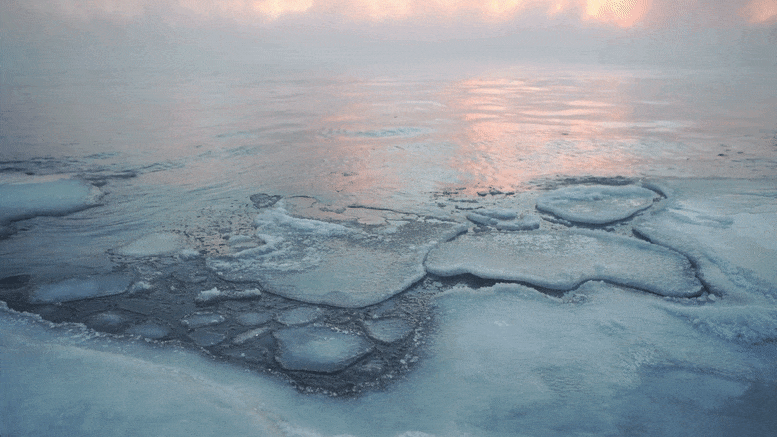
The Thwaites and Pine Island glaciers have been retreating at an accelerated pace and have already increased global sea levels.
A study finds that two major glaciers in the West Antarctic Ice Sheet (WAIS) are losing ice at the fastest rate for at least 5,500 years.
The huge glaciers that reach deep into the core of the ice sheet might contribute up to 3.4 meters to global sea level rise over the next few centuries if they continue to retreat at their current rate.
The East and West Antarctic Ice Sheets, which feed many distinct glaciers, cover Antarctica. The WAIS has been thinning at an accelerated pace in recent decades as a result of the warming climate. The Thwaites and Pine Island glaciers inside the ice sheet are especially sensitive to global warming and are already contributing to sea-level rise.
New research headed by the University of Maine and the British Antarctic Survey, collaborating with Imperial College London academics, has calculated the rate of local sea level rise – an indirect metric of ice loss – around these especially vulnerable glaciers.
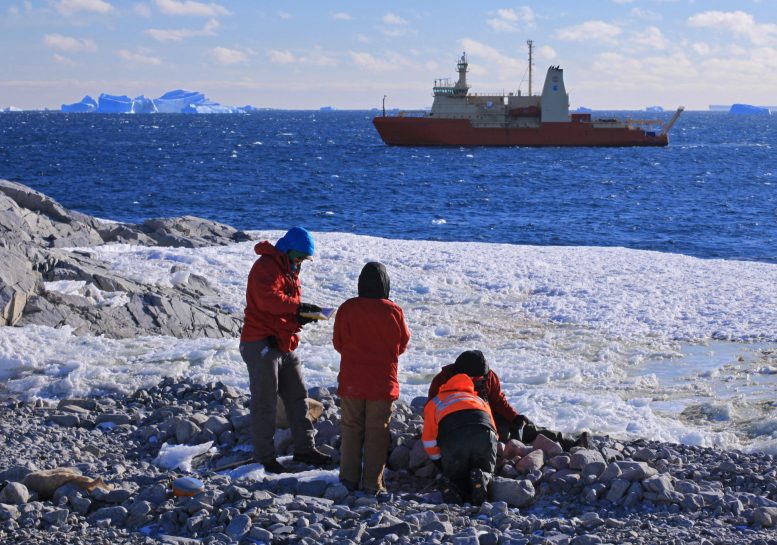
The researchers radiocarbon dated seashells and penguin bones on Antarctic beaches that are today elevated above modern sea level, like this one on Lindsey Island. Credit: James Kirkham, British Antarctic Survey
They discovered that the glaciers had started to retreat at a rate not seen in the previous 5,500 years. The Thwaites and Pine Island glaciers, with areas of 192,000 km2 (almost the size of the island of Great Britain) and 162,300 km2, respectively, have the potential to cause significant rises in global sea level.
Co-author Dr. Dylan Rood of Imperial’s Department of Earth Science and Engineering said: “We reveal that although these vulnerable glaciers were relatively stable during the past few millennia, their current rate of retreat is accelerating and already raising global sea level.
“These currently elevated rates of ice melting may signal that those vital arteries from the heart of the West Antarctic Ice Sheet have been ruptured, leading to accelerating flow into the ocean that is potentially disastrous for future global sea level in a warming world. Is it too late to stop the bleeding?”
The study was published in the journal Nature Geoscience.
Searching seashells
During the mid-Holocene period, over 5,000 years ago, the climate was warmer than today and thus sea levels were higher and glaciers smaller. The researchers wanted to study fluctuations in sea level since the mid-Holocene, so studied the remnants of old Antarctic beaches, which are today elevated above modern sea level.
They examined seashells and penguin bones on these beaches using radiocarbon dating – a technique that uses the radioactive decay of carbon locked in the shells and bones as a clock to tell us how long they have sat above sea level.
When heavy glaciers sit on the land, they push down or ‘load’ the Earth’s surface. After the glaciers’ ice melts or ‘unloads’, the land ‘bounces back’ so that what once was a beach is now higher than sea level. This explains why the local sea level for this land fell, while globally the water from the melting ice caused global sea levels to rise.
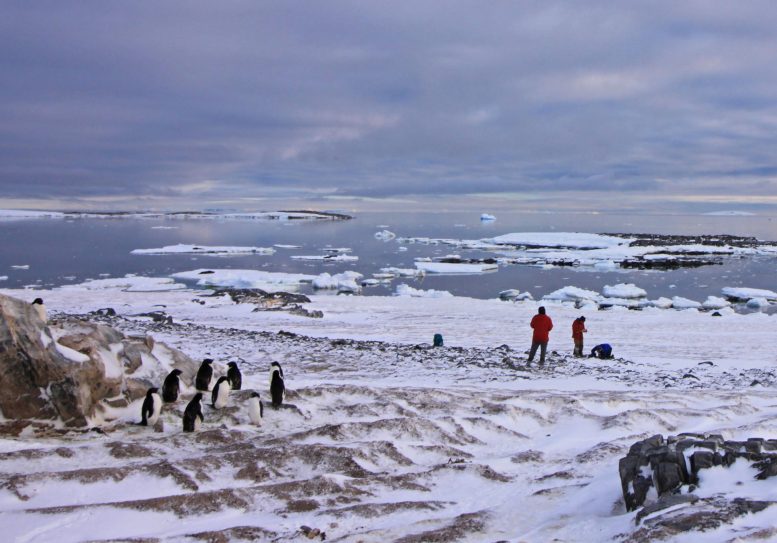
Pondered by a group of curious penguins, researchers on Edwards Island beach collect sea shells and bones. Credit: James Kirkham, British Antarctic Survey
By pinpointing the precise age of these beaches, they could tell when each beach appeared and therefore reconstruct changes in local, or ‘relative’, sea level over time.
The results showed a steady fall in relative sea level over the last 5,500 years, which the researchers interpret as a result of ice loss just prior to that time. This pattern is consistent with relatively stable glacier behavior with no evidence of large-scale glacier loss or advance.
They also showed that the rate of relative sea-level fall since the mid-Holocene was almost five times smaller than that measured today. The scientists found that the most likely reason for such a large difference is the recent rapid ice mass loss.
The researchers also compared their results to existing global models of the dynamics between ice and the Earth’s crust. Their data showed that the models did not accurately represent the sea-level rise history of the area during the mid- to late-Holocene based on their data. This study helps to paint a more accurate picture of the history of the region.
Although their data do not exclude the possibility of minor fluctuations of the Thwaites and Pine Island glaciers over the past 5,500 years, the researchers concluded that the simplest interpretation of their data is that these glaciers have been relatively stable since the mid-Holocene until recent times – and that the present-day rate of glacier retreat that has doubled over the past 30 years is, indeed, unprecedented over the last 5,500 years.
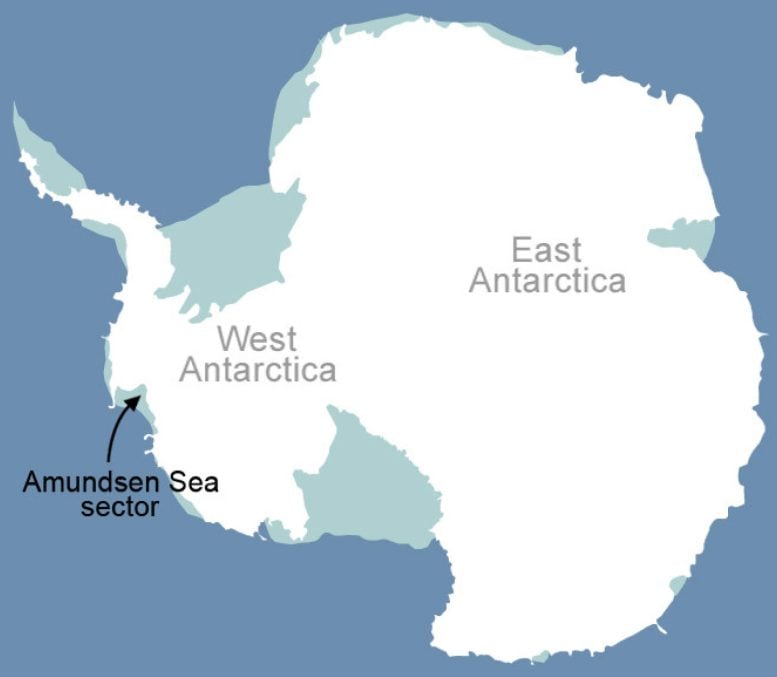
West Antarctic Ice Sheet has retreated and thinned at accelerated rates into the adjacent Amundsen Sea. Credit: NASA
Lead author Professor Brenda Hall of the University of Maine said: “Relative sea-level change allows you to see large-scale crustal loading and unloading by ice. For example, glacier readvance, which would result in crustal loading, would slow the rate of relative sea-level fall or potentially even cause submergence of the land below sea level.”
Stopping the bleeding
To better forecast the future fate of the ice sheet and its impact on global sea level, the International Thwaites Glacier Collaboration (ITGC) – the largest joint UK-US program of field science ever conducted in Antarctica – which Imperial researchers are involved with, will improve our understanding of the past behavior of the Thwaites glacier during climate conditions similar to today.
Important clues are also buried deep under the ice. To solve these mysteries, the researchers will be drilling through the glacier ice to collect rock underneath, which may contain evidence of whether current accelerating rates of melting are reversible or not.
Reference: “Relative sea-level data preclude major late Holocene ice-mass change in Pine Island Bay” by Scott Braddock, Brenda L. Hall, Joanne S. Johnson, Greg Balco, Meghan Spoth, Pippa L. Whitehouse, Seth Campbell, Brent M. Goehring, Dylan H. Rood, and John Woodward, 9 June 2022, Nature Geoscience.
DOI: 10.1038/s41561-022-00961-y

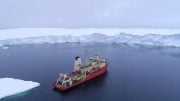

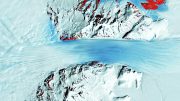

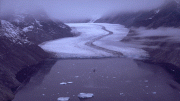
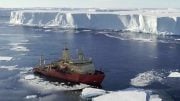
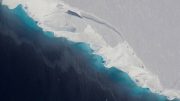
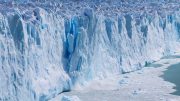
“… if they continue to retreat at their current rate.”
That is a big “if.” Why isn’t the East Antarctic Ice Sheet showing a similar retreat if humans are having a global impact? Why is it that the “Thwaites and Pine Island glaciers inside the ice sheet are especially sensitive to global warming?” Might the large number of volcanoes recently discovered under West Antarctica be playing a role in the anomalous behavior of Thwaites and Pine Island glaciers? Why do the authors assume that anthropogenic warming is responsible for accelerated melting and not even mention the geothermal heat at the bottom of the glaciers?
https://volcanofoundation.org/world-largest-volcanic-region-dicovered-antarctica/
Uh, nope. But volcanoes are always a denier staple. Remember the lies about how volcano co2 was supposedly huge compared to burning fossil fuels?
https://climate.nasa.gov/ask-nasa-climate/2982/fire-and-ice-why-volcanic-activity-is-not-melting-the-polar-ice-sheets/#:~:text=Unlike%20Greenland%2C%20however%2C%20there%27s%20substantial,volcanoes%20in%20West%20Antarctica%20alone.
Thank you for the link. I didn’t suggest that there was active vulcanism in West Antarctica. What I did ask, was why East and West Antarctica are responding differently to a supposed common anthropogenic driver. Your link states, “The team found the helium originated in Earth’s mantle, pointing to a volcanic heat source that MAY be triggering melting beneath the glacier and feeding the water network beneath it.” That is objective evidence. They then follow that up with a less convincing opinion, “… the researchers concluded that the volcanic heat is not a significant contributor to the glacial melt observed in the ocean in front of Pine Island Glacier Ice Shelf.”
The thing about volcanoes is that they are episodic, and notoriously difficult to predict when they may erupt. Thus, there could be a recent increase in heat, not only under the glaciers, but in the depths adjacent to the land mass.
https://scitechdaily.com/antarctic-orca-submarine-volcano-blasted-by-swarm-of-85000-earthquakes/
It may be true that the Antarctic Plate is stable, but what might be more germane, is what is happening with the plates adjacent to it.
You seem to be antagonistic towards skeptical claims. Considering how vast Antarctica is, and how poorly explored, you might want to show a little humility and dial back the aggression. If you already know everything, then you can’t learn anything new.
BTW, I am not one of those who claims that volcanic CO2 is driving the atmospheric increase. So, it is inappropriate to chastise me for holding that opinion. Although, I might point out that the best estimates for the annual anthro’ flux of CO2 is smaller than the uncertainty in the natural sources.